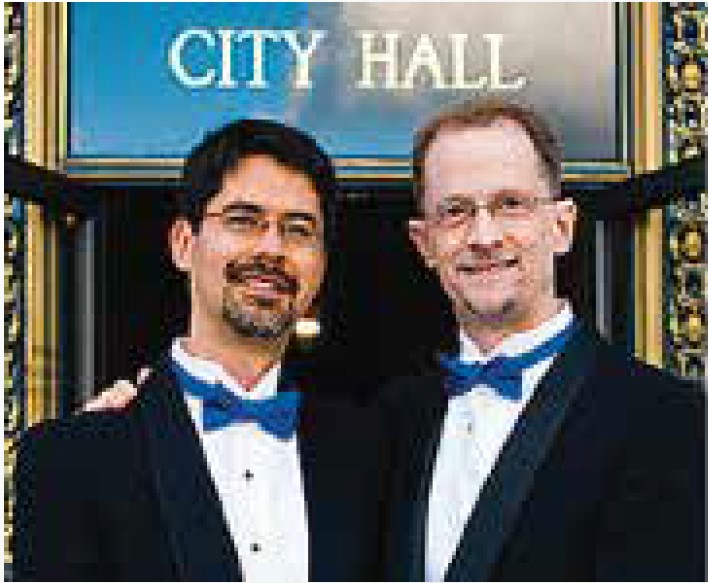
By Stuart Gaffney and John Lewis–
“Taking what is there just as it is and presenting it ‘just as it is.’” That’s how the masterful modern artist Lee Ufan describes the purpose of his sculpture and painting in a stunning recent exhibition of his work at Tokyo’s National Art Center. Ufan pursues his goals through austere works composed of natural elements that embody both profound stillness and dynamic movement simultaneously. We perceive LGBTIQ people as attempting to realize Ufan’s mission in our own way: to be free to be who we are just as we are, to love as we love, and to participate in a movement to achieve legal and social equality by presenting ourselves to the world as we truly are.
Being “just as you are” and presenting it to the world is complicated for many Japanese LGBTIQ people today because of immense social pressure to conform to perceived norms and a shared social ethic that prizes privacy in one’s personal life. But over the past few weeks, we’ve witnessed a beautiful queer kaleidoscope of Japan.

Most prominently, Tokyo, the world’s most populous metropolis, made international news when it began legally recognizing LGBTIQ couples by instituting a same-sex partnership system on November 1. Although these certificates are a far cry from the freedom to marry, the victory in Tokyo represents a vital step forward in the march to marriage equality in Japan. Now, over 62% of Japan’s population live in places that offer partnership certificates that provide some form of recognition and very limited rights to same-sex couples.
We were honored on the first day of partnerships to join in events with pioneering Japanese queer activists who had worked for years to achieve this goal. One of those activists, Soyoka Yamamoto, who along with her partner of many years Yoriko received a certificate, explained that creation of the partnerships sends a powerful message to young LGBTIQ Japanese that you can “be yourself” and “love whomever you want” and that Tokyo “has your back” in doing so.
Also seeking to make LGBTIQ history in Tokyo is the amazing Karen Yoda, who is running to become Mayor of Shinjuku City within metropolitan Tokyo. If successful, Yoda would make history as the first transgender mayor in Japan. We met Yoda three years ago when she was a city council member and will never forget her energetic presence and infectious smile. It was a joy to reconnect with Yoda and her longtime partner the evening the towering Tokyo Metropolitan Government Building was illuminated in rainbow colors to celebrate the beginning of Tokyo partnerships. We hope Yoda soon becomes Shinjuku’s mayor.
In the mountains 250 miles of Tokyo, the LGBTIQ community in Yamagata Prefecture was making history of its own when it held its first ever Pride march and celebration just days before Tokyo partnerships began. Interestingly, the event, named the “Yamagata Colorful Parade,” was organized primarily by allies and people who did not identify openly as LGBTIQ because of the social pressure and risk of discrimination that LGBTIQ people face in this conservative mountainous region.
However, many LGBTIQ people attended and marched. One was Mai Kato, a lesbian city council member in her 20s from Morioka, the capital city of nearby Iwate Prefecture. Attending Stonewall 50 in New York three years ago inspired Kato to run for office herself, and she along with her partner Ai (which means love in Japanese) are a compelling new presence in Japanese politics, representing the future of the queer movement.
Also present was the self-described “Wafuku Anarchist” (wafuku refers to traditional Japanese clothing), an extraordinary fashion designer who sports a mohawk, beard, red nail polish, and kimono styling. Meeting the Wafuku Anarchist was the perfect complement to our visit the week before to the pathbreaking art exhibition at the Shoto Museum of Art in Tokyo, entitled The Power of Clothing: History of Cross-Dressing in Japan. https://tinyurl.com/9msy43zz

The exhibition documents the 1,300-year-old tradition of cross-dressing in Japan that continues today. It invites viewers to “consider ‘the power of clothing’’ and “its ability to transcend the sexes” in the context of the recent movement to “dismantle the binary stipulation of male/female” and “recognize that human beings do not have any fixed gender.” The museum can “envision the very term ‘cross-dressing’ falling out of use” because “the term ‘cross-dressing’ itself is based on the premise” of illusory notions of “gender dichotomy” and “incontrovertible gender differences.”
In the final installation of the Ufan exhibition, a large “stone sits facing a blank white canvas on the wall.” In the words of Ufan, “the way the two face each other gives a sense of something organic and dynamic occurring. We envisioned a tabula rasa, a blank slate, something that existed before painting and before words or will exist after them.”
Can we as LGBTIQ people be an organic and dynamic blank slate as well? Can we simply be ourselves and love as we love without external interference of any form?
After the Ufan exhibition, John stopped by the 138-year-old Kanda Matsuya soba shop to slurp noodles. As he did, he watched the soba master meticulously hand cut each noodle from the carefully rolled dough. Can we as LGBTIQ people demonstrate that same quality of care for ourselves and each other? Our experiences in Japan over the past few weeks give us hope for the future.
John Lewis and Stuart Gaffney, together for over three decades, were plaintiffs in the California case for equal marriage rights decided by the California Supreme Court in 2008. Their leadership in the grassroots organization Marriage Equality USA contributed in 2015 to making same-sex marriage legal nationwide.
6/26 and Beyond
Published on November 17, 2022
Recent Comments